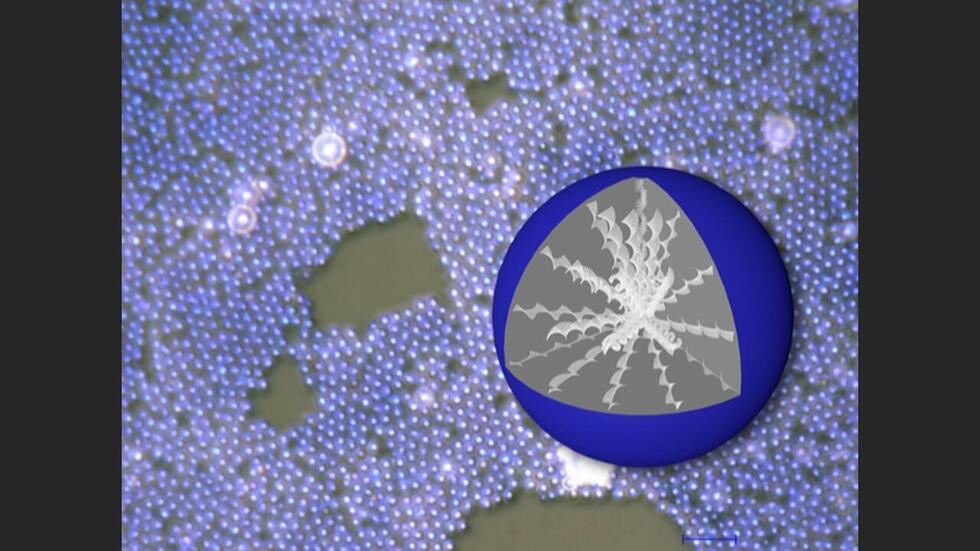
Chemistry
July 19, 2023
Liquid crystals that mimic beetle shell coloration units used to create more secure type of QR code
A research group led by Dr. Jialei He of Nagoya University's Graduate School of Engineering has developed a method for processing cholesteric liquid crystals (CLCs) into micrometer-sized spherical particles. CLCs are a type of liquid crystal that possess a helical structure, giving them unique optical properties and the ability to selectively reflect light. By combining spherical CLC particles with commercially available pigments, the researchers developed a unique anti-counterfeiting QR code that can only be displayed under a specific circular polarizer. The results were published in the journal Advanced Optical Materials.
CLCs are an example of how nature can be used in engineering. If you have ever noticed the iridescent wings of butterflies or the glossy coating on the exoskeletons of beetles, you have seen what CLCs can do. Once identified, CLCs that mimic the units that generate the colors of the exoskeletons of beetles are synthesized in the laboratory because of their unusual colors and properties, which lie between liquids and crystals.
Particularly useful are the optical properties of CLCs. They display unusual colors due to their unique molecular structure and optical properties that lead to the selective reflection of light at specific wavelengths. CLCs consist of long molecules that repeat themselves in the shape of a helix. In the helix, the vertical distance from where one region loops around and repeats itself is called the ‘pitch’. If the helix has repeating units that are close together, the liquid crystal has a short pitch and reflects shorter wavelengths of light, giving off blue and violet colors. However, those with a longer vertical space have longer wavelengths, leading to red or orange colors.
To complicate matters further, because the molecules that make up the crystal are arranged in a helix, the color can change depending on the viewer's orientation to the helix. Therefore, an infinite number of colors are possible depending on how the liquid crystal is viewed.
To utilize CLCs more effectively, researchers make spherical CLC particles. These particles are spherical and include the helix in a 3D matrix so that scientists can better control their coloration. However, a major problem is size. Current methods create 100-micrometer spherical CLC particles, which is too large for most uses. To tackle this problem, researchers Jialei He (he/him) and Yukikazu Takeoka (he/him) from Nagoya University and their colleagues used a mixture of solvents to create spherical CLC particles with a controlled particle size of a few micrometers using a technique called dispersion polymerization.
Since the samples were taken at room temperature, discovering the new technique was difficult. “The sample testing was a particularly challenging time due to the softness of the samples at room temperature, which is a property inherent to CLCs,” said Dr. He. “Consequently, a considerable amount of effort was required to find an appropriate method to characterize the samples without causing any damage.”
Since the pitch of the cholesteric liquid crystal of spherical CLCs particles of this size varies with the curvature of the particles, the researchers made the particles spherical with a uniform size distribution. This is known as a monodisperse sphere. “During the experiment, we unexpectedly discovered that the particle size of the microspheres significantly influenced the resulting structural color. We could produce a variety of colors depending on particle size,” said Dr. He. “We also found that covering the spherical CLC particles with the polymer polydimethylsiloxane improved the coloration and thermal stability.”
Cholesteric liquid crystals (CLCs) display unusual colors due to their unique molecular structure
and optical properties that lead to the selective reflection of light at specific wavelengths.
(Credit: Yukikazu Takeoka and Jialei He)
One potential application for this research is the creation of more secure QR codes that cannot be replicated. They could be created by taking advantage of a feature of the CLCs called chirality. Chirality refers to the property of an object or molecule that it cannot be superimposed onto its mirror image because of an asymmetry.
CLCs are chiral and have optical activity, so an anti-counterfeiting QR code could be created by combining the color of spherical CLCs particles with commercially available non-chiral pigments. The code could only be read when a specific circular polarizer that allows the non-chiral light through but not the chiral light of the QR code is used.
One potential application for this research is the creation of more secure QR codes
that cannot be replicated. (Credit: Yukikazu Takeoka and Jialei He)
“The development of spherical CLC particles development resulting from this research will provide new possibilities for low-cost structural color functions different from those of conventional color materials,” said Dr. Takeoka. “As well as being used a special functional pigment for anti-counterfeiting, it can also be used for other applications that take advantage of the circularly polarized structural color with little angle dependence.”
The study, "Particle Size Controlled Chiral Structural Color of Monodisperse Cholesteric Liquid Crystals Particles," was published in the journal Advanced Optical Materials on July 9,, 2023, at DOI: 10.1002/adom.202300296
Authors:
Jialei He, Sizhe Liu, Guohao Gao, Miki Sakai, Mitsuo Hara, Yuto Nakamura, Hideo Kishida, Takahiro Seki, and Yukikazu Takeoka
Media Contact:
Matthew Coslett
International Communications Office, Nagoya University
kouho-en@adm.nagoya-u.ac.jp